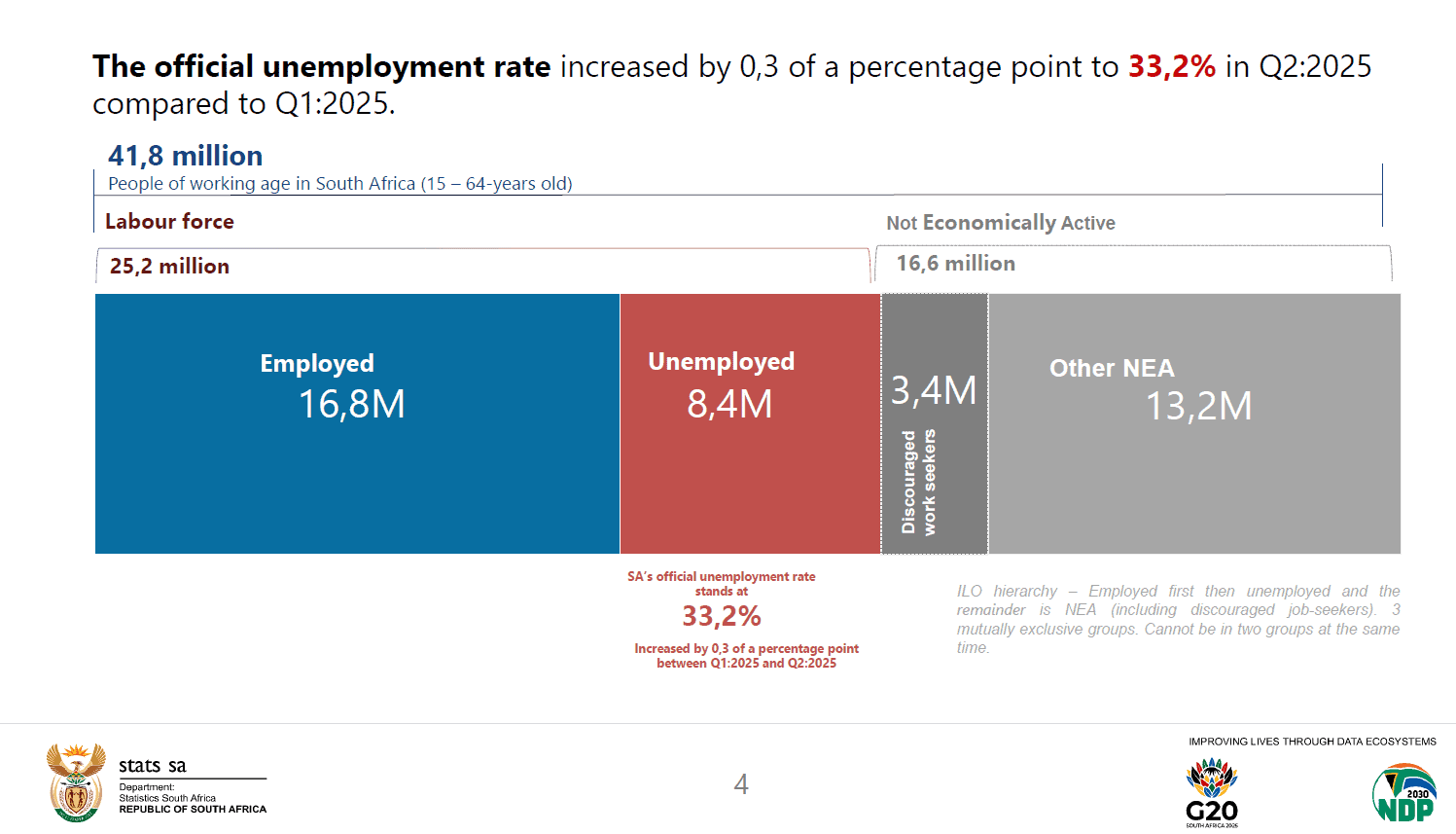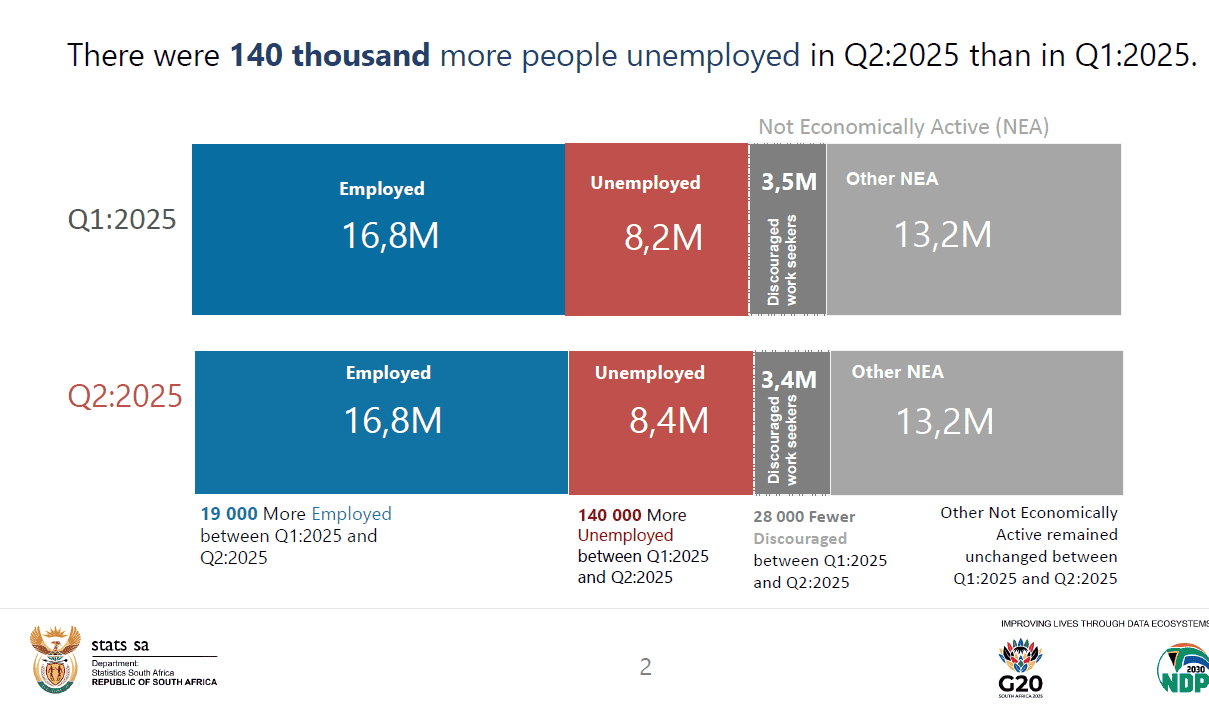While economic growth is not picking up, unemployment does.

The official unemployment rate increased again in the second quarter to 33.2% from 32.9% in the first quarter, with only 16.8 million people employed out of 41.8 million people of working age between the ages of 15 and 64.
According to the Quarterly Labour Force Survey for the second quarter issued by Statistics SA on Tuesday morning, the economy shed 140 000 jobs, pushing up the number of unemployed people to 8.4 million.
This graph shows the breakdown of the labour force in South Africa:

ALSO READ: Economy sheds jobs again in first quarter, unemployment worse than year ago
Decrease in discouraged work seekers
The survey shows that discouraged work-seekers decreased by 28 000 (down by 0.8%) and the number of people who were not economically active for reasons other than discouragement remained unchanged between the first quarter of 2025 and the second quarter of 2025.
This led to a decrease of 28 000 in the number of people who are not economically active to 16.6 million. These changes in employment and unemployment resulted in the official unemployment rate increasing by 0.3 of a percentage point from 32.9% in the first quarter to 33.2% in the second quarter of 2025.
The expanded unemployment rate in the second quarter of 2025 decreased by 0.2 of a percentage point to 42.9% when compared with the first quarter of 2025, which was 43.1%.

ALSO READ: Sectors showing growth in job opportunities in SA
Employment in formal sector increased, decreased in informal sector
The survey shows that the number of people employed in the formal sector increased by 34 000 in the second quarter, while employment in the informal sector decreased by 19 000.
The largest industry increases in employment were recorded in trade, that added 88 000 jobs, private households that added 28 000 jobs and construction that added 20 000 jobs.
However, community and social services shed 42 000 in the second quarter, while agriculture shed 24 000, finance 24 000, transport 15 000, utilities 6 000 and manufacturing 5 000.
The results also indicate that the highest increases in employment were observed in Gauteng where 95 000 more jobs were created and the Eastern Cape that added another 89 000.
The Western Cape, on the other hand, shed 117 000 jobs, KwaZulu-Natal 86 000 and the Northern Cape 28 000 in the second quarter.
ALSO READ: SA youth not unemployed, rather under-employed
Youth remain most vulnerable
The youth between the ages of 15 and 34 remain vulnerable in the labour market. This is clearly demonstrated by the results for the second quarter that show that the total number of unemployed youth increased by 39 000 to 4.9 million compared to the first quarter, while employed youth recorded an increase of 31 000 to 5.7 million.
As a result, the youth unemployment rate remained unchanged at 46.1% in the second quarter of 2025.
Approximately 3.6 million out of 10.3 million (35.2%) young people between the ages of 15 and 24 were not in employment, education or training (NEET). The overall NEET rate also remained unchanged between the second quarter of 2024 and the second quarter of 2025.
ALSO READ: SA women better qualified than men but not employed – study
Unemployment also worst for black Africans and women
The unemployment rate among the black African (37.1%) population group remains higher than the national average and other population groups. The black African unemployment rate has consistently been higher than the national average and other population groups over the past 10-year period.
The unemployment rate for women was 35.9% in the second quarter, with only 7.4 million employed out of 21 million. Compare this to the unemployment rate for men which is 4.2 million, with 9.4 million employed.
Since the second quarter of 2015, the unemployment rate for women has consistently been higher than that of men. It increased from 27.3% in 2015 to 35,9% in 2025.
Black African women continue to be the most vulnerable, with an unemployment rate of 40.2% in the second quarter of 2025, 4.3 percentage points higher than the national average for women at 35.9%.






